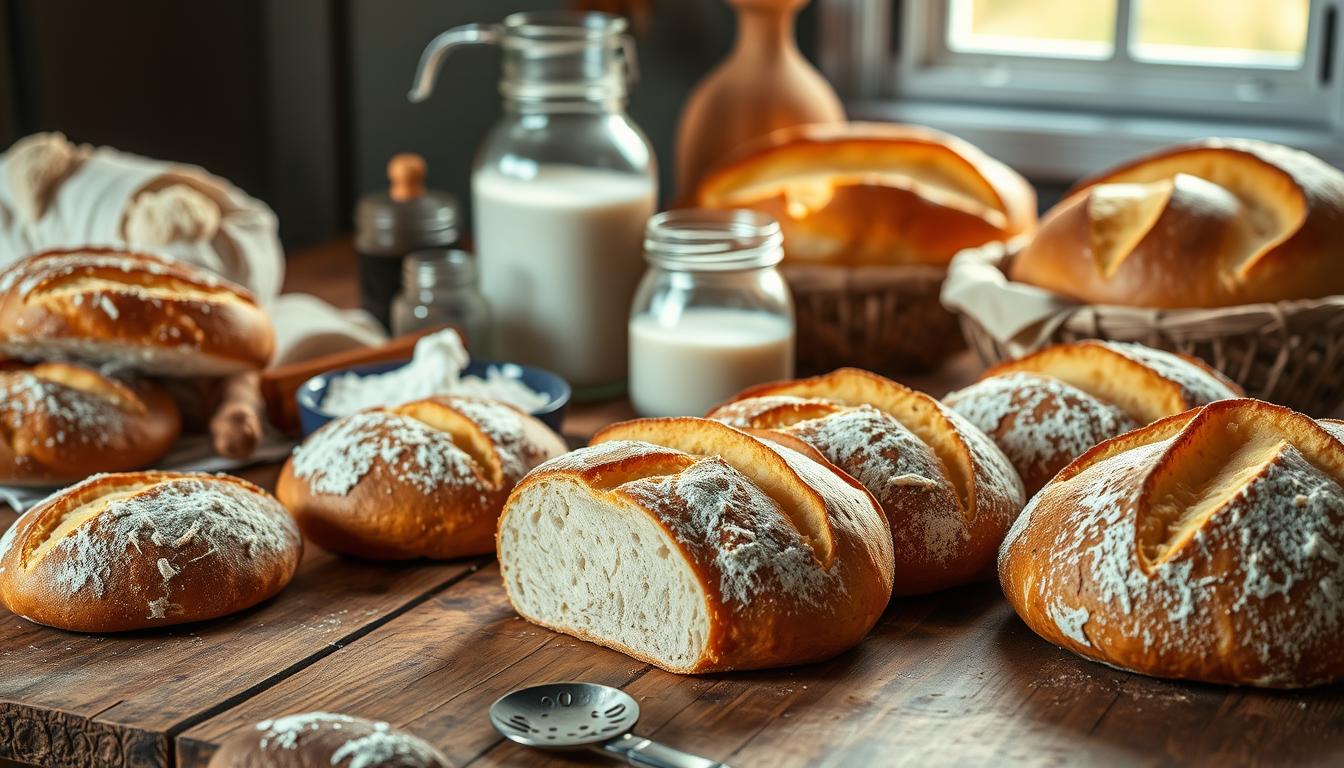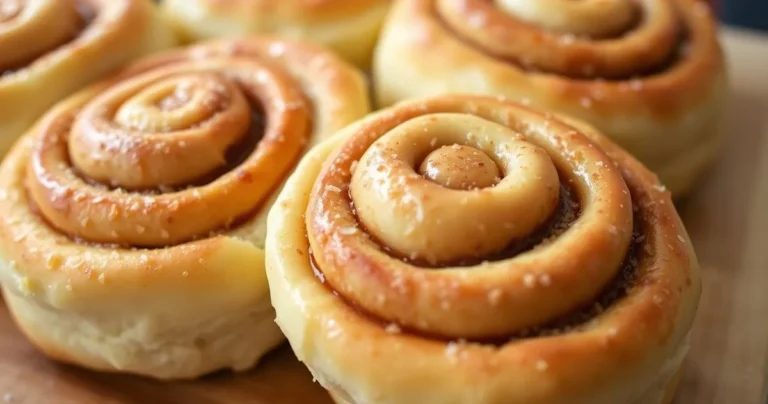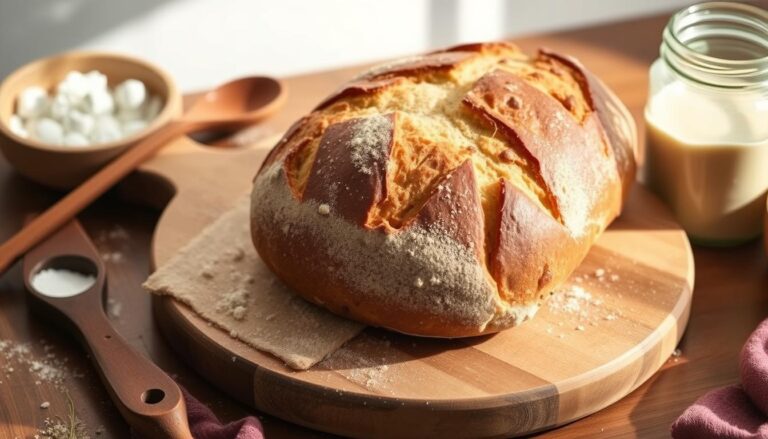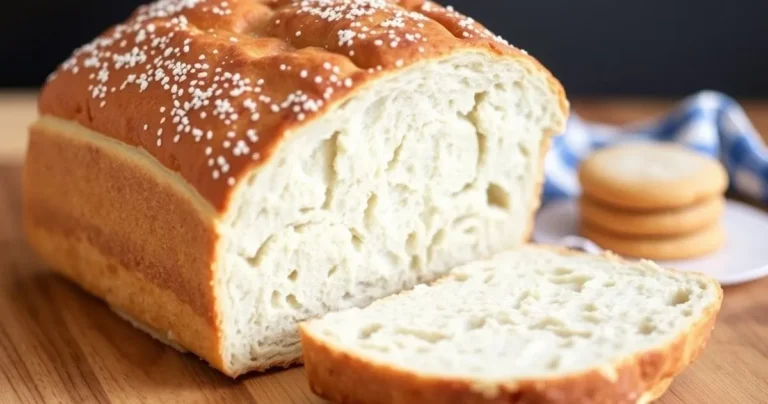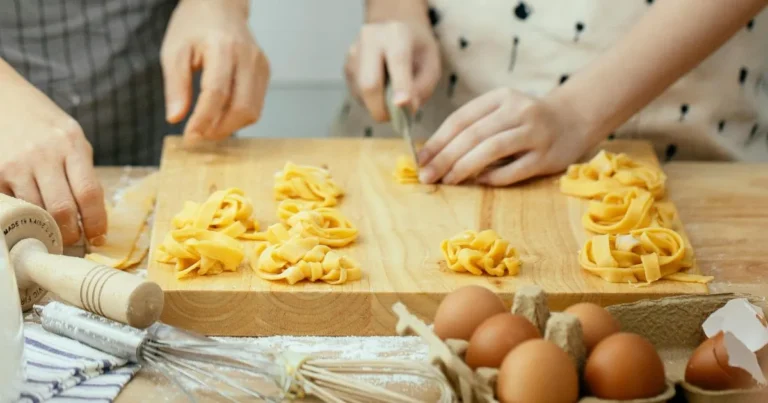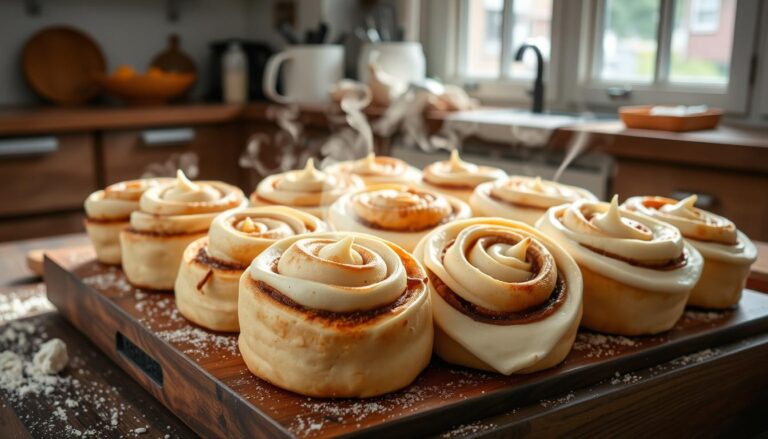What Can You Do With Sourdough Starter: Zero-Waste Recipe Guide
Every kitchen has its special spot, and for me, it’s where my sourdough starter resides. It started as a fun project during the pandemic lockdown. Now, it’s a key part of my zero-waste cooking and a source of endless creativity.
Sourdough recipes with starter are more than just bread. They open doors to turning “discard” into amazing dishes. Your starter is not just for rising dough; it’s a versatile ingredient ready to be discovered.
If you love baking or are just starting, this guide has something for you. You’ll find recipes for everything from crusty loaves to sweet and savory treats. You’ll learn to use every bit of your starter.
Get ready to change how you cook. These recipes will help you waste less food and explore new flavors and textures. It all starts with a simple mix of flour and water.
Table of Contents
Understanding Your Sourdough Starter Basics
Starting with sourdough recipes means knowing the basics of this living mix. It’s not just flour and water. It’s a mix of wild yeasts and bacteria that makes amazing breads and treats.
Making a strong sourdough starter takes time and care. It’s a fermentation power that adds special flavors and textures to your bakes.
Components of a Healthy Starter
A healthy sourdough starter has a few key parts:
- Wild yeasts for natural rising
- Lactic acid bacteria for deep flavors
- Right amount of water
- Regular feeding
Signs of Starter Readiness
Knowing when your starter is ready is key. Look for these signs:
- Consistent bubbling in the mix
- It rises and falls after feeding
- A tangy, pleasant smell
- A soft, fluffy feel
Optimal Temperature and Environment
Your starter needs the right conditions to thrive. Keep it at 70-80°F (21-27°C) and away from big temperature changes. A warm, quiet spot helps it grow strong and flavorful.
Pro tip: Treat your sourdough starter like a living pet—consistent care leads to the best sourdough recipes with starter!
Maintaining Your Starter for Zero Waste
Keeping your sourdough starter healthy is key for tasty baking. A well-cared-for starter means you always have a reliable base for baking. It also helps reduce food waste.
Your sourdough starter is a living mix of wild yeast and bacteria. To keep it healthy, you need to understand its needs. A regular routine is essential to keep it vibrant and ready for baking.
Feeding Your Starter Strategically
Having a good feeding schedule is important for sustainable baking. Here are some tips:
- Use the 1:10:10 feeding ratio (1 part starter, 10 parts water, 10 parts flour)
- Feed at consistent times to establish a predictable rhythm
- Discard excess starter before feeding to prevent overwhelming growth
Smart Storage Solutions
Storing your sourdough starter right can make it last longer and cut down on waste. You have different options based on how often you bake:
- Counter Storage: Room temperature for active, frequent bakers
- Refrigerator Storage: Slows fermentation for occasional bakers
- Dehydration: Long-term preservation technique
Scaling Your Starter Effectively
Learn to adjust your starter’s size based on your baking needs. Whether you’re baking a lot or just a little, scaling right prevents waste of ingredients.
Mastering these maintenance tips turns your sourdough starter into a trusted baking partner. It’s ready to help you make a variety of delicious treats.
What Can You Do with Sourdough
Sourdough isn’t just for making bread. It opens up a world of creativity in the kitchen. Meals with sourdough bread can turn simple recipes into amazing dishes with unique flavors and textures.
Discovering sourdough recipes beyond bread shows how versatile it is. These fermented creations add depth and complexity to many dishes, from breakfast to dinner.
- Pancakes with tangy sourdough base
- Crispy pizza crusts
- Savory crackers
- Tender waffles
- Flavorful dinner rolls
“Sourdough transforms ordinary ingredients into extraordinary meals.” – Artisan Baker’s Creed
The magic of sourdough is in its ability to make simple ingredients special. Wild yeasts and beneficial bacteria create complex flavors that regular recipes can’t. Your starter is a versatile kitchen friend, ready to make any dish better.
Whether you’re a home cook or a chef, knowing sourdough’s potential can change how you cook. These fermented recipes are not only tasty but also good for you, thanks to better digestibility.
Essential Tools and Ingredients for Sourdough Projects
Making sourdough bread is more than just a hobby. You need the right tools and ingredients to succeed. Knowing what you need can make your sourdough projects amazing.

Starting your sourdough journey means getting ready with special tools and ingredients. Choosing the right materials is key to making great sourdough bread.
Must-Have Equipment
- Digital kitchen scale (for precise measurements)
- Large glass or ceramic mixing bowl
- Proofing basket (banneton)
- Bread lame or sharp razor blade
- Dutch oven or heavy baking stone
- Instant-read thermometer
Recommended Flour Types
Your sourdough starter needs top-notch flour. Organic, untreated whole meal flours are best for wild yeast growth.
- Whole wheat flour
- Rye flour
- Spelt flour
- Bread flour
- Organic all-purpose flour
Additional Ingredients for Various Recipes
Trying new ingredients can make your sourdough even better. Add seeds, herbs, or specialty grains for extra flavor.
- Sea salt
- Olive oil
- Seeds (sunflower, pumpkin)
- Dried herbs
- Nuts
Good tools and ingredients are the start of making amazing sourdough bread. Learning about these basics will help you make delicious, artisan bread.
Classic Sourdough Bread Variations
Exploring meals with sourdough bread opens up a world of delicious possibilities. Sourdough bread isn’t just a simple staple—it’s a versatile ingredient. It can transform your culinary experience. From rustic country loaves to artisan-style creations, each variation brings unique textures and flavors to your table.
Crafting the perfect sourdough bread requires understanding different techniques and styles. Here are some classic sourdough bread variations you can master:
- Country-Style Boule: A round, hearty loaf with a thick crust
- Whole Wheat Sourdough: Nutty and nutritious variation
- Olive Rosemary Sourdough: Savory herb-infused bread
- Seeded Sourdough: Packed with nutritious seeds and grains
Each bread type offers unique characteristics for different meals with sourdough bread. The key is mastering fermentation and developing a strong starter culture.
| Bread Variation | Hydration Level | Fermentation Time |
|---|---|---|
| Country Boule | 75-80% | 12-18 hours |
| Whole Wheat | 80-85% | 16-24 hours |
| Olive Rosemary | 70-75% | 10-14 hours |
Pro tip: Experiment with different flour combinations and hydration levels to find your perfect sourdough bread recipe. The magic is in understanding how ingredients interact during fermentation.
Mastering sourdough bread variations takes practice, patience, and passion for baking.
Sweet Applications for Sourdough Discard
Turning sourdough discard into sweet treats is fun and helps reduce waste. It’s a great way to get creative with your sourdough starter. You’ll often have extra starter that can make delicious dishes, not just bread.

Your sourdough starter is very versatile. It adds a tangy flavor and special texture to many sweet dishes. The trick is knowing how to mix it into recipes that aren’t just bread.
Fluffy Pancakes and Crispy Waffles
Sourdough pancakes and waffles are a hit with those who love sourdough. They become incredibly light and tasty with starter discard. The fermentation makes your breakfast even more special.
- Crisp waffle exteriors with tender interiors
- Enhanced nutritional profile
- Minimal additional ingredients required
Quick Breads and Muffins
Banana bread, zucchini bread, and muffins get a boost with sourdough discard. They become tangy and have a better texture. This makes them go from good to great.
“Sourdough discard transforms simple quick breads into culinary masterpieces.” – Baking Enthusiast
Decadent Dessert Creations
Sourdough starter opens up amazing dessert options. From chocolate cakes to fruit cobblers, it adds moisture and depth. Try different recipes to find your favorite sourdough dessert.
- Chocolate sourdough brownies
- Sourdough apple crumble
- Tangy lemon sourdough cake
Pro tip: Always ensure your sourdough discard is at room temperature before incorporating it into sweet recipes for the best results.
Savory Discard Recipes
Turn your sourdough discard into tasty dishes that are not just bread. Sourdough recipes with starter let you use up kitchen waste. They make dishes that will amaze your taste buds.
Looking into sourdough recipe not bread options can change your cooking. These recipes use up your extra starter. They turn waste into amazing dishes.
- Crispy Sourdough Crackers: A perfect snack that transforms discard into a crunchy treat
- Savory Flatbreads: Quick and easy alternatives to traditional bread
- Sourdough Pizza Dough: A tangy base for your favorite toppings
Your sourdough starter can be a secret ingredient in many dishes. Try different herbs and spices to make unique flavors for your recipes.
“Waste not, want not” takes on a delicious meaning when you master sourdough discard cooking!
| Recipe | Preparation Time | Difficulty Level |
|---|---|---|
| Sourdough Crackers | 30 minutes | Easy |
| Sourdough Flatbread | 45 minutes | Medium |
| Sourdough Pizza Dough | 1 hour | Medium |
By trying these sourdough recipes, you’ll cut down on waste and improve your cooking. Each recipe is a new way to enjoy your sourdough discard. It shows that leftovers can be just as fun as the main dish.
Long-Term Storage Strategies
Keeping your sourdough starter alive is easy. You can store it for later use, whether you’re on a baking break or planning ahead. There are many ways to keep your starter fresh.
Bakers value their sourdough starters. They know how to store them right. This way, your starter stays active and ready for your next baking project.
Refrigeration: Slowing Down Your Starter
Refrigeration is great for short-term storage. It slows down your starter’s activity. This lets you feed it less often and keeps it healthy for up to 2 weeks.
- Reduce fermentation activity
- Extend time between feedings
- Preserve starter health for up to 2 weeks
Dehydration: Long-Term Preservation
Dehydration is perfect for long-term storage. Dried starter can last months or even years when stored right.
- Spread starter thinly on parchment paper
- Allow to dry completely at room temperature
- Break into small pieces
- Store in an airtight container
Reviving Your Stored Starter
Getting your starter back to life takes time and care. Start with small amounts and feed it regularly to build its strength.
Pro tip: Always use room temperature water and organic flour when reviving your sourdough starter.
Troubleshooting Common Starter Issues
Creating perfect sourdough recipes with starter can be tough. Even skilled bakers face problems that can stop their bread-making journey. Knowing how to find and fix these issues will keep your sourdough starter healthy and active.
Most sourdough starter problems come from a few main areas. Temperature, how wet it is, and how often you feed it are key to its health.
- Starter not rising: Check your room temperature and feeding schedule
- Unusual odors: Understand the difference between normal fermentation and spoilage
- Inconsistent performance: Learn to recognize starter readiness
- Potential mold growth: Know when to discard and restart
Pro tip: A healthy sourdough starter should smell slightly tangy and yeasty, not rancid or overly sour.
“Your starter is a living ecosystem. Treat it with care and attention.” – Professional Baker’s Wisdom
Key troubleshooting strategies for sourdough recipes with starter include:
- Maintain consistent room temperature (70-75°F is ideal)
- Use filtered or spring water
- Feed your starter with high-quality flour
- Develop a regular feeding routine
- Watch for signs of activity and health
If your starter seems slow, don’t worry. Small changes can often bring it back to life and get your sourdough recipes going again.
Conclusion
Your sourdough starter is more than just for bread. It’s a versatile friend for many tasty meals. You can make everything from tangy pancakes to savory crackers with it.
Using your sourdough starter can help you waste less. You can make sweet treats or hearty meals with it. Try different recipes and flavors to find your favorite.
Learning to use sourdough is a fun journey. Each batch of starter offers new chances to improve your cooking. Start small, be patient, and always try new things.
The best part is sharing your sourdough creations with others. Post pictures, share recipes, and inspire friends to try sourdough. Your starter connects you to old cooking ways and helps you make delicious, eco-friendly meals.
FAQ
What exactly is a sourdough starter?
A sourdough starter is a mix of flour, water, and wild yeasts and bacteria. It’s a natural way to make bread rise and gives it a tangy taste. It’s like a tiny ecosystem that makes food taste amazing.
How often should I feed my sourdough starter?
Feed your starter daily if it’s at room temperature. If it’s in the fridge, feed it once a week. Use the 1:10:10 ratio to keep it healthy. Feeding every 24 hours is best for most bakers.
Can I use sourdough starter for more than just bread?
Yes! You can use it in sweet treats like pancakes and waffles. It’s also great in savory dishes like pizza dough. It’s a fun way to add flavor to many recipes.
How do I know if my sourdough starter is healthy?
A healthy starter doubles in size after feeding, smells good, and is bubbly. It should rise well and feel light. If it’s separated, smells bad, or has mold, it needs help.
What’s the best way to store my sourdough starter?
Keep it at room temperature and feed it daily if you bake often. Store it in the fridge and feed it weekly if you bake less. You can also dehydrate it for months.
Can I freeze my sourdough starter?
Freezing is not the best option. It can harm the balance of your starter. Refrigeration or dehydration are better for storing it.
What can I do with sourdough discard?
Sourdough discard is very useful. Use it in pancakes, waffles, and more. It’s a great way to reduce waste and add flavor to your cooking.
How long does a sourdough starter live?
With care, a starter can live forever. Some are even centuries old. Just feed it regularly and keep it in the right environment.
What’s the difference between active and discard starter?
Active starter is at its best just after feeding. Discard is what you remove before feeding. Both are useful in different ways.
Can I make a sourdough starter from scratch?
Yes! Mix flour and water and let it sit. Feed it daily for 5-7 days until it’s active. It’s a simple process for home bakers.

